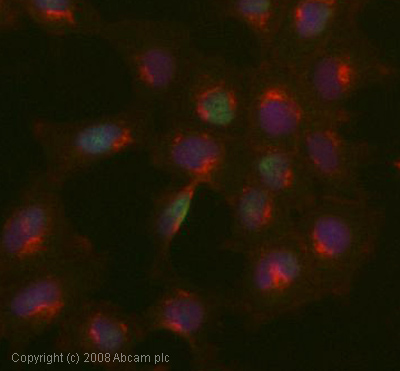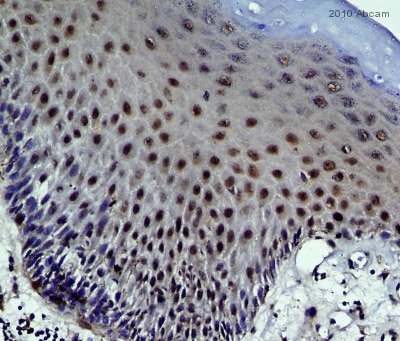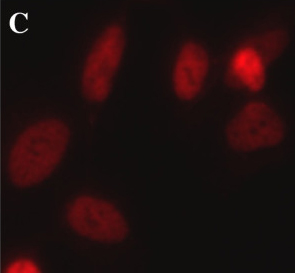![Lane 1 : MarkerLanes 2 - 5 : Anti-hnRNP K antibody [F45 P9 C7] (ab23644) at 1 µg/mlLane 1 : As aboveLane 2 : HeLa (Human epithelial carcinoma cell line) Nuclear Lysate (ab27251) at 20 µgLane 3 : HeLa (Human epithelial carcinoma cell line) Whole Cell Lysate (ab27252) at 20 µgLane 4 : Jurkat (Human T cell lymphoblast-like cell line) Whole Cell Lysate (ab7899) at 20 µgLane 5 : HEK293 (Human embryonic kidney cell line) Whole Cell Lysate (ab7902) at 20 µgSecondaryLanes 2 - 5 : Rabbit Anti-Mouse IgG H&L (HRP) (ab6728) at 1/10000 dilutionPerformed under reducing conditions.](http://www.bioprodhub.com/system/product_images/ab_products/2/sub_3/3395_ab23644%2520AP237728.jpg)
Lane 1 : MarkerLanes 2 - 5 : Anti-hnRNP K antibody [F45 P9 C7] (ab23644) at 1 µg/mlLane 1 : As aboveLane 2 : HeLa (Human epithelial carcinoma cell line) Nuclear Lysate (ab27251) at 20 µgLane 3 : HeLa (Human epithelial carcinoma cell line) Whole Cell Lysate (ab27252) at 20 µgLane 4 : Jurkat (Human T cell lymphoblast-like cell line) Whole Cell Lysate (ab7899) at 20 µgLane 5 : HEK293 (Human embryonic kidney cell line) Whole Cell Lysate (ab7902) at 20 µgSecondaryLanes 2 - 5 : Rabbit Anti-Mouse IgG H&L (HRP) (ab6728) at 1/10000 dilutionPerformed under reducing conditions.

Formalin-fixed, paraffin embedded tissue sections from human normal colon or human colon carcinoma stained with ab23644 mouse monoclonal to hnRNP K. hnRNP K expression is increased in the tumour tissue.

ICC/IF image of ab23644 stained human HepG2 cells. The cells were 4% PFA fixed (10 min), permabilised in 0.1% PBS-Tween (20 min) and incubated with the antibody (ab23644, 5µg/ml) for 1h at room temperature. 1%BSA / 10% normal goat serum / 0.3M glycine was used to block non-specific protein-protein interactions. The secondary antibody (green) was Alexa Fluor® 488 goat anti-mouse IgG (H+L) used at a 1/1000 dilution for 1h. Alexa Fluor® 594 WGA was used to label plasma membranes (red). DAPI was used to stain the cell nuclei (blue). This antibody also gave a positive IF result in HeLa, HEK 293 and MCF7 cells.

ab23644 staining hnRNP K in Human head and neck tissue sections by Immunohistochemistry (IHC-P - paraformaldehyde-fixed, paraffin-embedded sections). Tissue was fixed with formaldehyde and blocked with 1% BSA for 1 hour at 25°C; antigen retrieval was by heat mediation with Tris EDTA (pH9). Samples were incubated with primary antibody (1 µg/ml in TBST) for 16 hours at 4°C. An undiluted HRP-conjugated Rabbit anti-mouse polyclonal was used as the secondary antibody.See Abreview
![All lanes : Anti-hnRNP K antibody [F45 P9 C7] (ab23644) at 5 µg/mlLane 1 : NIH 3T3 (Mouse embryonic fibroblast cell line) Whole Cell Lysate Lane 2 : MEF1 (Mouse embryonic fibroblast cell line) Whole Cell Lysate Lane 3 : Testis (Mouse) Tissue Lysate Lane 4 : Lung (Mouse) Tissue LysateLane 5 : PC12 (Rat adrenal pheochromocytoma cell line) Whole Cell Lysate Lysates/proteins at 20 µg per lane.SecondaryGoat Anti-Mouse IgG H&L (HRP) preadsorbed (ab97040) at 1/5000 dilutiondeveloped using the ECL techniquePerformed under reducing conditions.](http://www.bioprodhub.com/system/product_images/ab_products/2/sub_3/3399_hnRNP-K-Primary-antibodies-ab23644-6.jpg)
All lanes : Anti-hnRNP K antibody [F45 P9 C7] (ab23644) at 5 µg/mlLane 1 : NIH 3T3 (Mouse embryonic fibroblast cell line) Whole Cell Lysate Lane 2 : MEF1 (Mouse embryonic fibroblast cell line) Whole Cell Lysate Lane 3 : Testis (Mouse) Tissue Lysate Lane 4 : Lung (Mouse) Tissue LysateLane 5 : PC12 (Rat adrenal pheochromocytoma cell line) Whole Cell Lysate Lysates/proteins at 20 µg per lane.SecondaryGoat Anti-Mouse IgG H&L (HRP) preadsorbed (ab97040) at 1/5000 dilutiondeveloped using the ECL techniquePerformed under reducing conditions.
![Overlay histogram showing HeLa cells stained with ab23644 (red line). The cells were fixed with 80% methanol (5 min) and then permeabilized with 0.1% PBS-Tween for 20 min. The cells were then incubated in 1x PBS / 10% normal goat serum / 0.3M glycine to block non-specific protein-protein interactions followed by the antibody (ab23644, 1µg/1x106 cells) for 30 min at 22ºC. The secondary antibody used was DyLight® 488 goat anti-mouse IgG (H+L) (ab96879) at 1/500 dilution for 30 min at 22ºC. Isotype control antibody (black line) was mouse IgG1 [ICIGG1] (ab91353, 2µg/1x106 cells) used under the same conditions. Acquisition of >5,000 events was performed. This antibody gave a positive signal in HeLa cells fixed with 4% paraformaldehyde (10 min)/permeabilized with 0.1% PBS-Tween for 20 min used under the same conditions.](http://www.bioprodhub.com/system/product_images/ab_products/2/sub_3/3400_hnRNP-K-Primary-antibodies-ab23644-7.jpg)
Overlay histogram showing HeLa cells stained with ab23644 (red line). The cells were fixed with 80% methanol (5 min) and then permeabilized with 0.1% PBS-Tween for 20 min. The cells were then incubated in 1x PBS / 10% normal goat serum / 0.3M glycine to block non-specific protein-protein interactions followed by the antibody (ab23644, 1µg/1x106 cells) for 30 min at 22ºC. The secondary antibody used was DyLight® 488 goat anti-mouse IgG (H+L) (ab96879) at 1/500 dilution for 30 min at 22ºC. Isotype control antibody (black line) was mouse IgG1 [ICIGG1] (ab91353, 2µg/1x106 cells) used under the same conditions. Acquisition of >5,000 events was performed. This antibody gave a positive signal in HeLa cells fixed with 4% paraformaldehyde (10 min)/permeabilized with 0.1% PBS-Tween for 20 min used under the same conditions.

Immunofluorescence analysis of SH-SY5Y cells staining hnRNP K with ab23644. Cells were fixed with paraformaldehyde in PBS for 30 min and permeabilized with 90% chilled methanol for 5 min. After blocking for 1 hour with 10% normal goat serum, cells were incubated with primary antibody (1/200) overnight at 4°C. An AlexaFluor®-conjugated goat anti-mouse IgG (1/500) was used as the secondary antibody.
![Lane 1 : MarkerLanes 2 - 5 : Anti-hnRNP K antibody [F45 P9 C7] (ab23644) at 1 µg/mlLane 1 : As aboveLane 2 : HeLa (Human epithelial carcinoma cell line) Nuclear Lysate (ab27251) at 20 µgLane 3 : HeLa (Human epithelial carcinoma cell line) Whole Cell Lysate (ab27252) at 20 µgLane 4 : Jurkat (Human T cell lymphoblast-like cell line) Whole Cell Lysate (ab7899) at 20 µgLane 5 : HEK293 (Human embryonic kidney cell line) Whole Cell Lysate (ab7902) at 20 µgSecondaryLanes 2 - 5 : Rabbit Anti-Mouse IgG H&L (HRP) (ab6728) at 1/10000 dilutionPerformed under reducing conditions.](http://www.bioprodhub.com/system/product_images/ab_products/2/sub_3/3395_ab23644%2520AP237728.jpg)



![All lanes : Anti-hnRNP K antibody [F45 P9 C7] (ab23644) at 5 µg/mlLane 1 : NIH 3T3 (Mouse embryonic fibroblast cell line) Whole Cell Lysate Lane 2 : MEF1 (Mouse embryonic fibroblast cell line) Whole Cell Lysate Lane 3 : Testis (Mouse) Tissue Lysate Lane 4 : Lung (Mouse) Tissue LysateLane 5 : PC12 (Rat adrenal pheochromocytoma cell line) Whole Cell Lysate Lysates/proteins at 20 µg per lane.SecondaryGoat Anti-Mouse IgG H&L (HRP) preadsorbed (ab97040) at 1/5000 dilutiondeveloped using the ECL techniquePerformed under reducing conditions.](http://www.bioprodhub.com/system/product_images/ab_products/2/sub_3/3399_hnRNP-K-Primary-antibodies-ab23644-6.jpg)
![Overlay histogram showing HeLa cells stained with ab23644 (red line). The cells were fixed with 80% methanol (5 min) and then permeabilized with 0.1% PBS-Tween for 20 min. The cells were then incubated in 1x PBS / 10% normal goat serum / 0.3M glycine to block non-specific protein-protein interactions followed by the antibody (ab23644, 1µg/1x106 cells) for 30 min at 22ºC. The secondary antibody used was DyLight® 488 goat anti-mouse IgG (H+L) (ab96879) at 1/500 dilution for 30 min at 22ºC. Isotype control antibody (black line) was mouse IgG1 [ICIGG1] (ab91353, 2µg/1x106 cells) used under the same conditions. Acquisition of >5,000 events was performed. This antibody gave a positive signal in HeLa cells fixed with 4% paraformaldehyde (10 min)/permeabilized with 0.1% PBS-Tween for 20 min used under the same conditions.](http://www.bioprodhub.com/system/product_images/ab_products/2/sub_3/3400_hnRNP-K-Primary-antibodies-ab23644-7.jpg)
